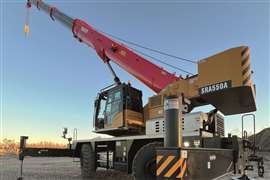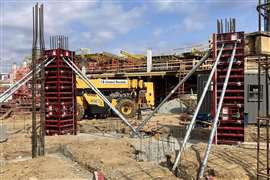Stretching the brand: IRN talks to Douglas Anderson of GAP Group in the UK
05 October 2012

The UK’s GAP Group is establishing a series of specialist rental divisions, including Lifting equipment and Non-mechanical plant. Murray Pollok asked joint managing director Douglas Anderson about the strategy.
The benefits of establishing specialist rental operations within a core general rentals business have long been understood, and have not been lost on GAP Group, the Glasgow, UK-based plant and tool rental company.
Such divisions allow rental companies to sell more to existing customers, leverage an existing infrastructure (primarily the depot network), and generate higher returns by offering specialist expertise.
For Douglas Anderson, who is joint managing director of GAP along with brother Iain, the logic is very clear. “What we’re trying to do is customer focused rather than product or sector focused. 80 to 90% of business with the new divisions is with existing customers. We’re pushing at open doors. I’m not saying that makes it easy, but it’s easier.”
The key was getting the core plant and tools business to a national level, a task that has now been largely completed with 60 stories throughout the UK. “The effort and investment in the national plant and tool business now gives us economies of scale”, he explains, “We’ve got scale, national coverage, brand awareness, so we can start stretching the brand.”
GAP started with a Non-mechanical plant division in 2009 - renting fences, props and steel plates - but more significant was the creation of the Lifting division at the start of 2011. That division, which supplies chain hoists, jacks, stone handling tools and conveyors, now has around 18 locations, with 12 opened in 2011, a further 10 this year and the same number scheduled for 2013.
The model for these openings is now well established. “A significant number are opened within existing plant and tool depots”, says Mr Anderson, “but they have separate staff, vehicles, computers – there is no crossover.”
This means GAP can move these businesses into their own locations once they reach a certain size. “We move them next door – we’ve done that in Liverpool and Middlesbrough, and we’re about to do it at Heathrow. In Portsmouth it’s around the corner. We want them next door – the guys will talk to each other, you get benefits.”
When the Lifting division is complete, there will be around 34 depots, and most of these will be stand-alone locations.
The beauty of this model is that GAP can be certain about when it opens the new Lifting branches because it already has the depots in place; “Of the ten we opened this year, eight are in GAP depots. We will open them, it’s in our control,” Mr Anderson tells IRN.
The Lifting division will also allow GAP to piggy-back further specialist divisions, with surveying equipment next on the agenda. “The surveying division will go with the stand-alone lifting depots”, he says, “Once the lifting depots move out of the plant and tool stores, surveying will go with them. There will be a surveying expert in each lifting depot, but with the same drivers and administration.” Around half of the lifting depots will house surveying.
The non-mechanical division, likely to have around 8 locations, uses a different model, with new, stand-alone locations needed because of the space requirements of the products.
Mr Anderson doesn’t get involved operationally in these divisions, but is central to getting them up and running. Paul Glover, who has been responsible for rolling out the lifting depots, is now getting some help to manage the depots that are up and running, with GAP’s former major accounts manager Karen Smith, based in London, taking on that role. That will free up Mr Glover to concentrate on opening further lifting sites.
And it is becoming a sizeable business. On an annualised basis the specialist divisions already account for around 7-8% of revenues, with the target for the specialist operations to account for around a quarter of turnover within the next five years.
Of course, that will require additional divisions. Mr Anderson says safety equipment and communications fit well into the lifting and surveying locations, while there are obvious opportunities in areas like power, powered access and telehandlers.
These additional divisions will be added not because GAP particularly wants to have the products, but because they fit the new divisional model and because customers will request them, says Mr Anderson.
In fact, GAP has resisted these products in the past for specific reasons. In the case of power, for example, Mr Anderson says he prefers products like compressors which get occasional rather than constant use.
With powered access, he hasn’t liked what he has seen in that sector in the past; the way, as he sees it, that powered access renters run their businesses and the way AWP manufacturers have sometimes made it too easy for new entrants to move into the market. When they do move into access, it will be with a specialist division, competing head to head with powered access specialists.
In some cases his mind doesn’t seem fully made-up, as with telehandlers; “Are we going to have a run at UK Forks and Fork Rent? I don’t know, maybe we will.”
The order in which these additional divisions are established has yet to be established, and in any case will probably wait until the lifting, non-mechanical and surveying divisions are completed.
Helped by the new specialist divisions - if not the still faltering UK economy - GAP has managed to grow following the financial crisis. Revenues dropped to £74.3 million in the year 2010/11 from a peak of £88.5 million in 2008/9, but sales in the year to 31 March 2012 were up around 14% to £84 million and so far this year sales are up another 17%.
Mr Anderson says gains in the all-important national accounts market are proving important. “We have loads of national accounts where we are doing less than Speedy or A-Plant. We are the junior partner, but that is changing. We are getting more professional, and we’ve got the equipment. We’re winning - our success rate on preferred supplier tenders is 90%."
Illustrating the importance of national accounts is the fact that around of 70% of GAP’s business is handled by the 40-strong call-centre team sitting directly outside Mr Anderson’s office at GAP’s headquarters in Glasgow.
He is hopeful that GAP’s plant and tool revenues will reach around £130 million within five years - equivalent to compound annual growth rate of around 10% - with specialist divisions contributing between £25 and £30 million, but with a bigger profit contribution at around 30-40% of the total.
The state of the economy, and in particular the construction sector, doesn’t worry him unduly. “It’s still a big market, and there is lots of infrastructure work, essential construction. Construction as an industry is still pretty big...the cake is a reasonable size, even if it isn’t booming.”
Still, with the specialist divisions project and national accounts business continuing to expand, GAP is not overly dependent for on a fast expanding construction sector. He points out that GAP’s market share in plant and tools is currently in the 3 to 5% range, with plenty of room to grow.
Both Douglas Anderson and brother Iain are still working full-time in the business and will be for “several years”, says Douglas Anderson, “There’s plenty to do, and it’s still fun, though less than it was.” (He says government bureaucracy has made it less enjoyable to run a business than it used to be.)
It took him and his brother 20 years to create a national plant and tool business, and he won’t be going anywhere until the first specialists divisions are firmly established. As he says; “I like to finish things I start.”
BOX STORY
Operated plant? No thanks
GAP Group doesn’t rent equipment with operators – it sold that business back in 1986 - and is unlikely to start doing so any time soon.
Douglas Anderson has strong views about the subject, and his objections boil down to two issues. First, employing a cadre of machine operators is an administrative burden, and second - and more important - he believes that it is very difficult to build a scalable, national business in operated plant.
The reason is that it is too easy for owner operators with good reputations to set up local or regional operations with very low overheads.
“You can run a fleet of 25 operated machines from your back bedroom”, he says, “It’s easy for them to compete with the big players because they don’t have the same overheads. With us, we’re 50% plant hirers and 50% administrators.”
Mr Anderson says there is always a demand for knowledgeable operators; “A good operator will save you a lot of money. Everyone can pull the levers, but it’s about being site-savvy. It’s not just digging a hole; it’s about understanding the process.”
This means that contractors often ask for particular operators, which leads many of these operators to establish their own, small businesses.
“There is no A-Plant, Speedy or GAP doing national operated plant hire”, he says, “I don’t think it can be done, it doesn’t lend itself to scalability.”






